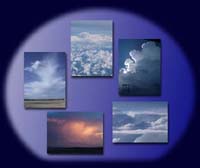Fog |
|
| Advection Fog | |
| Radiation Fog | |
| Overview | |
Radiation Fog
|
During the cloudless nights the ground of the valleys below the Pulpit Rock cooled so much down that radiation fog was formed (ValleyFog2.jpg). Additionally there were sources of water vapour, because near Villach and Klagenfurt a river and several lakes are located in the valley. However the stratus layer covered a much larger area than just the lakes. Because of the calm air it can be assumed that the radiation fog had also been formed without any humidity source at the ground. During the forenoon the fog cover raised more and more (ValleyFog1.jpg and ValleyFog3.jpg) until the vantage point disappeared also inside the fog layer (Fog1.jpg, Fog3.jpg and Fog7.jpg).
|
In ValleyFog4.jpg and ValleyFog5.jpg the fog arose only above
the valley and not further away from the humidity source, the
river "Kyll", which is situated in the valley in front
of the mountains. In the case of the valley fog in Carinthia (see
above) the air was cooled down by infrared emission during the
night. This resulted in super-saturation and therefore cloud formation.
In contrast the valley fog in Gerolstein arose, since the air
was super-saturated by humidification. Further possibilities to
reach super-saturation are described in Advection
Fog, Isobaric
Mix Clouds and
Mix Clouds II. |
ValleyFog1.jpg to ValleyFog3.jpg, Fog1.jpg to Fog7.jpg: S. Borrmann,
Pulpit Rock, Carinthia, Austria, December 2002 |
![]()
















